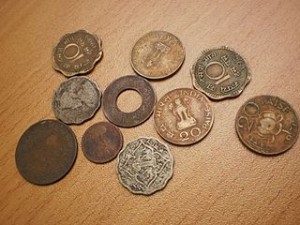From Kamarkat to Toffee: The Life of the Indian Coin
The 50 paise coin seems to be on its way out and getting back a toffee instead of small change is routine now. Our reader, retired Brigadier Suryanarayan on the decline of the coin.
Small change seems to be on its way out
Pic: Silver Talkies
A newspaper had queried a few days ago, if it was the ‘End of the road for 50-paisa coins?’ That made me recall the first Economics lesson in B.Com in the late- fifties — that there were four functions of money: Medium of Exchange; Measurement of Value; Standard of Deferred Payments and Store of Value. The lecturer had used a couplet then: ‘Money is a matter of functions four: a medium, a measure, a standard, a store.’
As a ‘medium,’ money has facilitated transactions of goods and services for centuries. Services and goods providers sell their services/goods in exchange for money, thus eliminating the inconvenience of barter. But money can operate as medium only when it is accepted as such. Coins have existed for centuries when their intrinsic value, ie, value of metal in the coin, made them acceptable, eg, a silver-Rupee coin had a ‘tola’ (11.6gm) of silver and an eight anna coin, half of it. When coins are minted, the intrinsic value is much lower than the face value; this changes over a period of time. They go out of circulation when the intrinsic value of the coin exceeds the face value and people start hoarding them.
A collection of old coins
Pic: Wikimedia Commons
It slowly became more expensive to manufacture smaller denomination coins than their face value! As a 4-5 year old, if I gave half-anna (1/32 of Re) to a petty trader for a ‘kamarkat’ (stick-jaw) I got back a quarter-anna (1/64 of Re). That humble quarter was made of copper. Even during the war-years, when it was made thin and with a huge hole in the middle, like the Polo-peppermint, its face value was more! But, in a few years, its copper had more worth than what it could buy! Soon, I was forced to accept another kamarkat/murukku, instead of a quarter-anna.
Raging inflation too makes it virtually worthless to accept small coins. In Jun 2011, RBI phased out the 25p coin, known as ‘chavannie’. It now appears 50p coin or ‘athannee’ (eight annas before 1957) … smallest denomination of Indian currency is becoming unacceptable. I am sure all of you would have been persuaded to accept a toffee in lieu of a Rupee, as a balance due to you for the past many years. I was shocked recently when a shop-keeper gave a finger-size-chocolate for a balance of Rs5! I had to argue and get a coin. To teach him a lesson, I gave back the same Rs5 and asked for the same chocolate; he should know that it was customer’s sweet will to demand services/goods for money! For how long more … I leave it to you to guess.
The day may not be far when for Rs 100 balance, you get some unwanted item … but I hope, not in my lifetime!
Comments

Arjun
19 May, 2014
I still remember the days when Bata Shoes would be priced as 299 (I think they still price them as some 99) and in return you would get a toffee or a stamp.









Post a comment